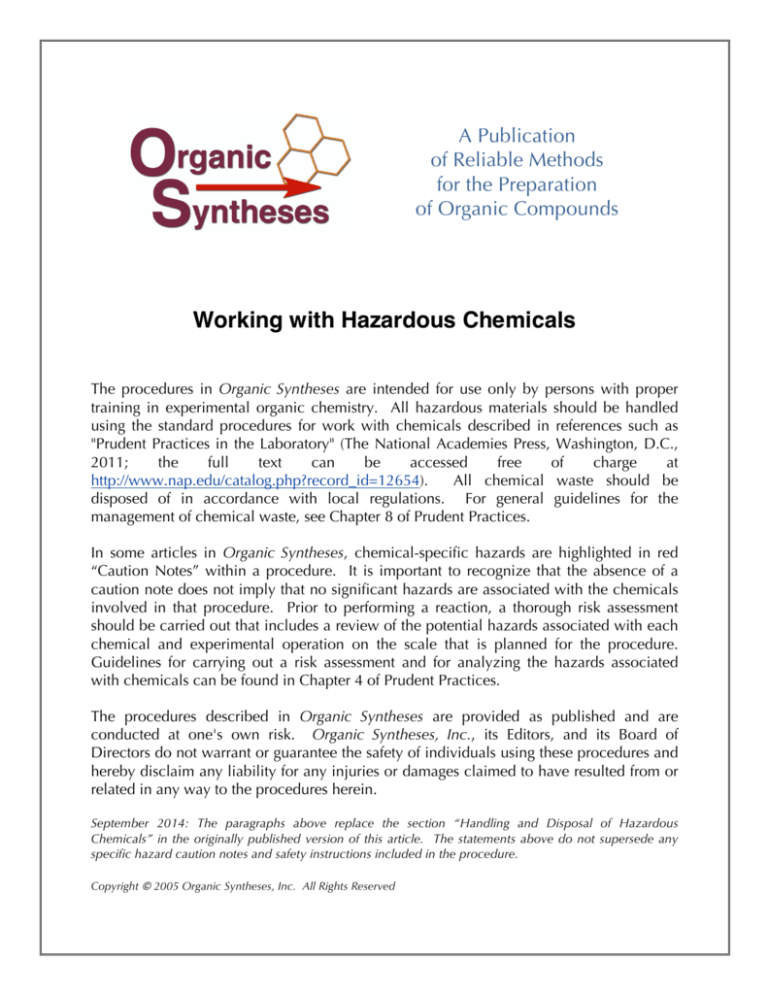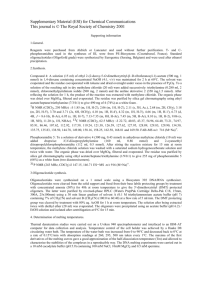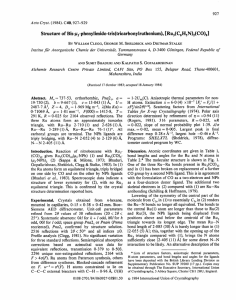
A Publication
of Reliable Methods
for the Preparation
of Organic Compounds
Working with Hazardous Chemicals
The procedures in Organic Syntheses are intended for use only by persons with proper
training in experimental organic chemistry. All hazardous materials should be handled
using the standard procedures for work with chemicals described in references such as
"Prudent Practices in the Laboratory" (The National Academies Press, Washington, D.C.,
2011;
the
full
text
can
be
accessed
free
of
charge
at
http://www.nap.edu/catalog.php?record_id=12654).
All chemical waste should be
disposed of in accordance with local regulations. For general guidelines for the
management of chemical waste, see Chapter 8 of Prudent Practices.
In some articles in Organic Syntheses, chemical-specific hazards are highlighted in red
“Caution Notes” within a procedure. It is important to recognize that the absence of a
caution note does not imply that no significant hazards are associated with the chemicals
involved in that procedure. Prior to performing a reaction, a thorough risk assessment
should be carried out that includes a review of the potential hazards associated with each
chemical and experimental operation on the scale that is planned for the procedure.
Guidelines for carrying out a risk assessment and for analyzing the hazards associated
with chemicals can be found in Chapter 4 of Prudent Practices.
The procedures described in Organic Syntheses are provided as published and are
conducted at one's own risk. Organic Syntheses, Inc., its Editors, and its Board of
Directors do not warrant or guarantee the safety of individuals using these procedures and
hereby disclaim any liability for any injuries or damages claimed to have resulted from or
related in any way to the procedures herein.
September 2014: The paragraphs above replace the section “Handling and Disposal of Hazardous
Chemicals” in the originally published version of this article. The statements above do not supersede any
specific hazard caution notes and safety instructions included in the procedure.
Copyright © 2005 Organic Syntheses, Inc. All Rights Reserved
DOI:10.15227/orgsyn.082.0010
Organic Syntheses, Vol. 82, p. 10-17 (2005); Coll. Vol. 11, p. 17-24 (2009).
PREPARATION OF OPTICALLY ACTIVE (R,R)-HYDROBENZOIN
FROM BENZOIN OR BENZIL
1,2-Ethanediol, 1,2-diphenyl-, (1R,2R)Ts
C6H5
N
C6H5
N
H2
Ru
A
O
C6H5
C6H5
Cl
HCOOH/N(C2H5)3, DMF
40 ˚C, 48 h
OH
OH
RuCl[(S,S)-Tsdpen[(p-cymene)
C6H5
C6H5
OH
B
OH
O
C6H5
C6H5
O
RuCl[(S,S)-Tsdpen[(p-cymene)
HCOOH/N(C2H5)3
40 ˚C, 24 h
C6H5
C6H5
OH
Submitted by Takao Ikariya,1 Shohei Hashiguchi,2 Kunihiko Murata,3 and
Ryoji Noyori.4
Checked by Peter Wipf and David Amantini.
1. Procedure
A. A 100 g scale synthesis from rac-Benzoin: A 1 L four-necked,
round-bottomed flask equipped with a mechanical stirrer, a reflux condenser
bearing an inert gas inlet tube, a thermometer and a dropping funnel is
charged with 290 mL (2.08 mol) of triethylamine (Note 1). The
triethylamine is cooled to 4 °C in an ice bath and formic acid (97.0 mL, 2.57
mol) is added slowly (Note 2). To the mixture of formic acid and
triethylamine at ambient temperature is added rac-benzoin (Note 3) (170 g,
0.801 mol), RuCl[1S,2S)-N-p-toluenesulfonyl-1,2-diphenylethanediamine](6-p-cymene) (Notes 4 and 5) (0.204 g, 0.321 mmol), and dry DMF (Notes
1 and 6) (80 mL) . After the reaction mixture is stirred at 40 °C for 48 h, 300
mL of water is added at 0 °C with stirring (Note 7). The pale pink
precipitate is filtered through a Büchner funnel, washed with water (2 x 500
mL), and dried in vacuo to give a white solid in 97% yield (Note 8). The
crude product is dissolved in hot methanol (700 mL) at 60 °C. A small
10
amount of insoluble material is removed through filtration and the filtrate is
cooled initially to room temperature and then to 0 to 5 °C to provide white
crystals. The crystalline product is isolated by filtration, washed with cooled
(ice bath) 2-propanol (400 mL), and dried to provide 129.7 g of optically
pure (R,R)-hydrobenzoin as white crystals (dl > 99%, 99.9% ee, Note 9).
Concentration of the mother liquors and another recrystallization from
methanol (100 mL) provides a second crop of the product, 19.1 g (dl > 99%,
99.9% ee, Note 9). The overall yield is 148.8 g (87%).
B.
A 10 g scale synthesis from benzil: A 100 mL four-necked,
round-bottomed flask equipped with a mechanical stirrer, a reflux condenser
bearing an inert gas inlet tube, a thermometer, and a dropping funnel is
charged with a mixture of formic acid (8.70 mL, 230 mmol) and
triethylamine (19.0 mL, 136 mmol) in a similar manner to Procedure A. To
this formic acid-triethylamine mixture at ambient temperature is added
benzil (Note 3) (11.0 g, 52.3 mmol), and RuCl[(1S,2S)-N-p-toluenesulfonyl1,2-diphenylethanediamine](6-p-cymene) (33.3 mg, 0.0524 mmol) (Note
6). After the reaction mixture is stirred at 40 °C for 24 h, 50 mL of water is
added at 0 °C with stirring. The pale pink precipitate is filtered through a
Büchner funnel, washed with water (50 mL), and dried in vacuo to give a
white solid in 95% yield. The crude product is dissolved in hot methanol
(50 mL) at 60 °C. The filtrate is cooled to room temperature and then to -40
°C to give white crystals. The crystalline product is isolated by filtration,
washed with cooled (ice-bath) 2-propanol (10 mL), and dried to provide 9.3
g of optically pure (R,R)-hydrobenzoin as white crystals (82%, 100% ee).
2. Notes
1.
Triethylamine and formic acid were purchased from Kanto
Chemical Company and used without further purification. The Checkers
used chemicals from Fisher and Fluka. An azeotropic mixture of
triethylamine and formic acid is commercially available but could not be
used for this reaction (see discussion section). Dry DMF was purchased
from J. T. Baker.
2.
The reaction of triethylamine with formic acid is exothermic
and may proceed violently unless performed by controlled addition.
3.
Benzoin and benzil were purchased from Kanto Chemical
Company and used without further purification. The Checkers used
11
chemicals from TCI and Acros, respectively. Substituted benzoins were
prepared by benzoin condensation of the corresponding ring-substituted
benzaldehydes.5
4.
The Checkers used the following procedure for the preparation
of (1S,2S)-N-p-toluenesulfonyl-1,2-diphenylethanediamine (TsDPEN): a dry
CH2Cl2 solution (10 mL) of p-toluenesulfonyl chloride (0.893 g, 4.69 mmol)
was added dropwise over 5 h (syringe pump addition) to a mixture of (S,S)DPEN (0.995 g, 4.69 mmol) and triethylamine (0.69 mL, 4.5 mmol) in dry
CH2Cl2 (30 mL) at 0 °C. After the reaction mixture was stirred at 0 °C for 6
h, the solution was washed with water (10 mL x 2) and saturated NaCl
solution (10 mL) and then dried with Na2SO4. The solvent was removed
under reduced pressure to give 1.659 g of crude white solid product.
Recrystallization from ethyl acetate (8 mL) gave 1.146 g (67% yield) of the
desired product as white crystals.
5.
Commercially available chiral Ru complexes from Kanto
Chemical Company were used by the Submitters; however, the complexes
were prepared by the Checkers following a modified literature procedure.6
(R)-RuCl[(1S,2S)-p-TsNCH(C6H5)CH(C6H5)NH2](6-p-cymene):
A
6
7
mixture of [RuCl2( -p-cymene)]2 (0.651 g, 1.06 mmol), (S,S)-TsDPEN8
(0.780 g, 2.13 mmol), and triethylamine (0.60 mL, 4.3 mmol) in 2-propanol
(21 mL) was stirred at 80 °C for 1 h. The orange solution was concentrated
and the resulting solid was collected by filtration, washed with a small
amount of water and dried under reduced pressure to give the chiral Ru
complex. After recrystallization from methanol (20 mL), 0.552 g of pure Ru
(II) catalyst were collected as bright orange crystals. After two additional
recrystallizations of the concentrated mother liquor from methanol (8.0 and
5.0 mL, respectively), an additional 0.327 g of pure catalyst were collected.
The overall yield was 0.879 g (65%). mp > 100 °C (dec.); IR (KBr) [cm-1]:
3468, 3277, 3220 (H-N), 3062, 3029 (H–Caromat.), 2961, 2872 (H–Caliphat.);
MS (EI): m/z (%) = 603 (63), 601 (100), 600 (66), 599 (58); 1H NMR (300
MHz, CDCl3, 25 °C, TMS): 1.37 (m, 6H, CH(CH3)2), 2.21 (s, 3H, CH3 in
p-cymene), 2.35 (s, 3H, CH3 in p-Ts), 3.12 (m, 1H, CH(CH3)2), 3.52 (m, 2H,
NHH and HCNH2), 3.73 (d, 1H, J = 10.5 Hz, HCN-p-Ts), 5.72 (m, 4H,
CHaromat. in p-cymene), 6.04 (m, 1H, NHH), 6.34–7.05 (m, 14H, p-CH3C6H4SO2NCH(C6H5)CH(C6H5)NH2).
6.
DMF was used to maintain the homogeneity of the reaction
mixture, but it is not crucial for the catalysis to be efficient and practical. On
12
small scale the addition of DMF is not needed. In fact, the reaction of benzil
with a substrate to catalyst ratio (S/C) of 1,000 (4.7 M) in a mixture of
HCOOH
and
N(C2H5)3
containing
the
(S,S)-Ru
catalyst
(benzil:HCOOH:N(C2H5)3 = 1:4.4:2.6) proceeded heterogeneously at the
early stages of the reaction because of the low solubility of benzil. After
about ten minutes, the reaction mixture changed to a completely
homogenous solution, giving almost the same results as with DMF as
solvent.
7.
On large scale, the reaction flask should be connected to an Ar
gas inlet to allow CO2 to escape.
8.
The diastereoselectivity of the product, dl:meso = 95.0:5.0, was
determined by integration in the 1H NMR (300 MHz, CDCl3); (R,R)hydrobenzoin: 3.07 (s, 2H, OH), 4.86 (s, 2H, CH–OH), 7.25–7.40 (m,
10H, aromatic ring protons), meso-hydrobenzoin: 2.33 (s, 2H, OH), 4.98
(s, 2H, CHOH), 7.30–7.45 (m, 10H, aromatic ring protons).
9.
(R,R)-Hydrobenzoin: []D25 + 91.6 (c 1.05, ethanol), (lit.9a
[]D23, +95 (c 0.87 ethanol), 99% ee (R,R)). HPLC separation conditions,
(column: CHIRALCEL OJ (4.6 mm i.d. x 250 mm), eluent: hexane/2propanol = 90/10, flow rate: 1.0 mL/min, temp: 25 °C, detection UV 254
nm); retention time, (S,S)-hydrobenzoin, 14.2 min, (R,R)-hydrobenzoin, 16.5
min.
Safety and Waste Disposal Information
All hazardous materials should be handled and disposed of in
accordance with "Prudent Practices in the Laboratory"; National Academy
Press; Washington, DC, 1995.
3. Discussion
Optically active hydrobenzoins are useful building blocks for the
stereoselective synthesis of various biologically active compounds, as well
as chiral ligands and auxiliaries.
The preparation of these chiral
hydrobenzoins by Sharpless asymmetric dihydroxylation of trans-stilbene is
one of the most convenient and well established methods.9 Asymmetric
reduction of readily available benzils or benzoins would be a promising and
widely applicable approach; however, no practical reduction systems have
13
been reported except for oxazaborolidine-catalyzed reductions of benzils
with borane/methylsulfide.10 Direct asymmetric hydrogenation of benzils or
benzoins catalyzed by well-established Ru-BINAP complexes could
potentially lead to optically active 1,2-diols. However, meso-isomers are
obtained as the major products, because the substrate control of the hydroxy
ketone intermediate favors meso-diol formation.11 The procedure described
herein provides a highly efficient method accessing the desired chiral
hydrobenzoins in high enantiomeric excess using commercially available
chiral (Ru(II) catalysts, RuCl(TsDPEN) (6-arene),6,12 and easily handled
reagents such as benzils or benzoins as substrates and a formic acid and
triethylamine mixture as the hydrogen source.13
A mixture of formic acid and triethylamine is the best hydrogen donor
for this reduction. In the absence of triethylamine, no conversion of
benzoins or benzils was observed. The addition of triethylamine to the
reaction mixture causes a significant increase in the conversion of the
substrates. In the reaction of benzoin, a formic acid:triethylamine molar
ratio of 3.2:2.6 to 3.2:4.4 gives the best catalyst performance in terms of
both reactivity and stereoselectivity. The reduction of benzil requires a
molar ratio of 4.4:2.6 to 4.4:4.4. The reaction with an azeotropic mixture of
formic acid and triethylamine (5:2) gave no conversion under otherwise
identical conditions as described in the Procedure.
The success of this asymmetric reduction of benzil or benzoin leading
to the optically active hydrobenzoin with the formic acid and triethylamine
mixture relies strongly on the nature of benzoin with a configurationally
labile stereogenic center and the enantiomer discrimination ability of the
chiral Ru complexes. Due to a sufficiently rapid stereomutation of benzoins
under the basic reaction conditions, the dynamic kinetic resolution of
benzoins allows the diastereo- and enantioselective synthesis of optically
Table 1. Asymmetic Reduction of Benzils with (S,S)-Ru Catalyst
O
R
R
O
S/C
H
1000
40
24
1000
40
200
1000
p-OCH3
p-F
a
R
OH
temp, °C time, h yield, %
R
p-CH3
14
OH
R
dl:meso
ee, %
100
98.4:1.6
>99
48
67
96.7:3.3
>99
35
48
75
94.4:5.6
>99
40
24
100
94.2:5.8
>99
Conditions: (S,S)-Ru cat 0.005 mmol, ketone/HCOOH/N(C2H5)3 = 1/4.4/2.6.
a ketone/HCOOH/N(C H ) = 4.4/4.4 in 1.2 M DMF.
2 53
active hydrobenzoins.13 Reduction of (R)-benzoin with the (S,S)-Ru catalyst
in DMF under the same conditions gave (R,R)-hydrobenzoin quantitatively
and in 100% ee, indicating that the (S,S)-Ru catalyst favors the reaction of
(R)-benzoin.13a The rate of the reduction of (R)-benzoin with the (S,S)-Ru
catalyst proceeds 55 times faster than the S-isomer. The slow-reacting Sisomer undergoes a rapid racemization.
Various benzil derivatives bearing substituents on aromatic rings can
be reduced stereoselectively to the chiral hydrobenzoins in high ee’s and in
good yields (Table 1). The benzils with electron-donating substituents such
as methyl or methoxy groups are reduced with excellent enantioselectivity
but more slowly, while the reduction of p-fluorobenzil proceeded rapidly, as
expected, giving a product with a high ee.13
O
X
OH
(S,S)-Ru cat
X
HCOOH/N(C2H5)3, 28-40 °C, 16-20 hr
R
(S/C = 200)
O
R
R
R = H, X = H, >99% yield, 98% ee
R = H, X = CH3, 96% yield, 97% ee
R = m-Cl, X = H, >99% yield, 97% ee
R = p-Cl, X = H, >99% yield, 95% ee
R = m-OCH3, X = H, >99% yield, 96% ee
R = p-OCH3, X = H, >99% yield, 97% ee
R = H, X = COC6H5, 99% yield, dl/meso = 94/6, 99% ee
R = H, X = CN, 100% yield, 98% ee (S/C = 1000)
R = H, X = N3, 65% yield, 92% ee
R = H, X = NO2, 90% yield, 98% ee (in 1.0 M DMF)
R = p-F, X = NO2, 95% yield, 96% ee (in 1.0 M DMF)
R = p-CH3, X = NO2, 67% yield, 95% ee (in 1.0 M DMF)
R = H, X = Cl, 36% yield, 91% ee (S/C = 1000 in 1.0 M AcOEt)
OH
(S,S)-Ru cat
HCOOH/N(C2H5)3, 28°C, 48 hr
R
R = CH2, >99% yield, 99% ee
R = (CH2)2, 99% yield, 99% ee
S/C = 200
O
OH
(S,S)-Ru cat
S
X
S/C = 200
HCOOH/N(C2H5)3, 28°C, 40-65 hr
S
X
X = S, 95% yield, 99% ee
X = SO2, 95% yield, 98% ee
(S,S)-Ru cat: RuCl[(S,S)-Tsdpen](6-mesitylene) or RuCl[(S,S)-Tsdpen](p-cymene)
Figure 1. Examples of Chiral Ru Catalyzed Asymmetric
Reduction of Ketones with HCOOH/N(C2H5)3
15
The described, chiral Ru catalyst-promoted asymmetric transfer
hydrogenation with a formic acid and triethylamine mixture is also
applicable to the enantioselective reduction of acetophenone,12 ringsubstituted acetophenone derivatives,12 -substituted acetophenones,14,15
acetylpyridine derivatives,16 and functionalized ketones17,18 leading to the
corresponding optically active alcohols in excellent ee. These asymmetric
reductions with the chiral Ru catalyst are characterized by a rapid, carbonyl
group-selective transformation because of the coordinatively saturated
nature of the diamine-based Ru hydride complexes.6,17 The neighboring
groups at the -position of the carbonyl group do not interact with the metal
center, leading to excellent reactivity and enantioselectivity.
Some
representative examples are listed in Figure 1.
1.
2.
3.
4.
5.
6.
7.
8.
9.
10.
11.
12.
13.
14.
16
Graduate School of Science and Engineering, Frontier Collaborative Research
Center, Tokyo Institute of Technology, Meguro-ku, Tokyo 152-8552 Japan.
Takeda Chemical Industries, ltd., Yodogawa-ku, Osaka, Japan.
Kanto Chemical Corp. Inc., Central Research Laboratory, Soka, Saitama, Japan.
Department of Chemistry and Research Center for Materials Science, Nagoya
University, Chikusa-ku, Nagoya, Japan.
Ide, W. S.; Buck, J. S. In “Organic Reactions”, Adams, M.; Bachmann, W. E.;
Blatt, A. H.; Fieser, L. F.; Johnson, J. R.; Snyder, H. R. ed. John Wiley & Sons,
New York, 1948, 4, pp. 269-304.
Haack, K.-J.; Hashiguchi, S.; Fujii, A.; Ikariya, A.; Noyori, R. Angew. Chem., Int.
Ed. Engl. 1997, 36, 285-288.
Bennett, M. W.; Huang, T.-N.,; Matheson, T. W.; Smith, A. K. Inorg. Synth.
1982, 21, 74-78.
Oda, T.; Irie, R.; Katuski, T.; Okawa, H. Synlett 1992, 641-643.
(a) Wang, Z.-M.; Sharpless, K. B. J. Org. Chem. 1994, 59, 8302-8303. (b) Kolb,
H. C.; VanNieuwenhze, M. S.; Sharpless, K. B. Chem. Rev. 1994, 94, 2483-2547.
Quallich, G. J.; Keavey, K. N.; Woodall, T. M.; Tetrahedron Lett. 1995, 36, 47294732.
Kitamura, M.; Ohkuma, T.; Inoue, S.; Sayo, N.; Kumobayashi, H.; Akutagawa,
S.; Ohta, T.; Takaya, H.; Noyori, R. J. Am. Chem. Soc. 1988, 110, 629-631.
Hashiguchi, S.; Fujii, A.; Takehara, J.; Ikariya, T.; Noyori, R. J. Am. Chem. Soc.
1995, 117, 7562-7563.
(a) Murata, K.; Okano, K.; Miyagi, M.; Iwane, H.; Noyori, R.; Ikariya, T. Org.
Lett. 1999, 1, 1119-1121. (b) Koike, T.; Murata, K.; Ikariya, T. Org. Lett. 2000,
2, 3833-3836.
(a) Hamada, T.; Torii, T.; Izawa, K.; Noyori, R.; Ikariya, T. Org. Lett. 2002, 4,
4373-4376. (b) Hamada, T.; Torii, T.; Izawa, K.; Ikariya, T. Tetrahedron 2004,
60, 7411-7417. (c) Hamada, T.; Torii, T.; Onishi, T.; Izawa, K.; Ikariya, T. J. Org.
Chem. 2004, 69, 7391-7394.
15.
16.
17.
18.
Watanabe, M.; Murata, K.; Ikariya, T. J. Org. Chem. 2002, 67, 1712-1715.
Okano, K.; Murata, K.; Ikariya, T. Tetrahedron Lett. 2000, 41, 9277-9280.
(a) Noyori, R.; Hashiguchi, S. Acc. Chem. Res. 1997, 30, 97-102; (b) Ikariya, T.;
Murata, K. and Noyori, R. Org. Biomol. Chem. 2006, 4, 393-406; (c) Ikariya, T.
Blacker, A. J., Acc. Chem. Res. in press.
(a) Palmer, M. J.; Wills, M. Tetrahedron: Asymmetry 1999, 10, 2045-2061. (b)
Cross, D. J.; Kenny, J. A.; Houson, I.; Cambell, L.; Walsgrove, T.; Wills, M.
Tetrahedron: Asymmetry 2001, 12, 1801-1806. (c) Mohar, B.; Valleix, A.;
Desmurs, J.-R.; Felemez, M.; Wagner, A.; Mioskowski, C. Chem. Commun. 2001,
2572-2573. (d) Eustache, F.; Dalko, P. I.; Cossy, J. Org. Lett. 2002, 4, 12631265.
Appendix
Chemical Abstracts Nomenclature (Registry Number)
Formic acid; (64-18-6)
Triethylamine: Ethanamine, N,N-diethyl-; (121-44-8)
rac-Benzoin: Ethanone, 2-hydroxy-1,2-diphenyl-; (19-53-9)
RuCl[(1S,2S)--TsNCH(C6H5)CH(C6H5)NH2](6-p-cymene): Ruthenium, [N-[(1S,2S)-2(amino-N)-1,2-diphenylethyl]-4-methyl-benzenesulfonamidatoN]chloro[(1,2,3,4,5,6-)-1-methyl-4-(1-methylethyl)benzene]-; (192139-90-5)
(R,R)-Hydrobenzoin: 1,2-Ethanediol, 1,2-diphenyl-, (1R,2R)-; (52340-78-0)
2-Propanol; (67-63-0)
Benzil: Ethanedione, diphenyl-; (134-81-6)
17









